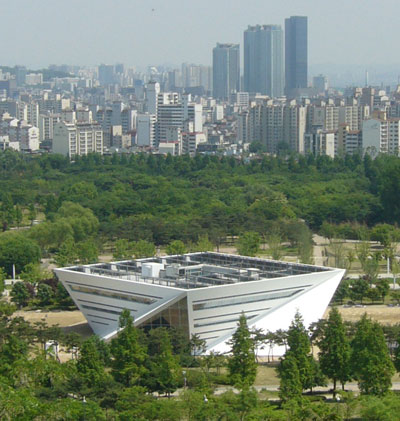| Dec 11, 2012 |
A zero-energy building for Seoul
|
|
(Nanowerk News) With the Energy Dream Center, the Seoul metropolitan government realizes its goal to construct a center for renewable energy. With a floor space of 3500 m2, the zero energy building houses exhibitions and offers a wide range of information related to the field of renewable energy. Headed by the Fraunhofer Institute for Solar Energy Systems ISE, an interdisciplinary team designed the building and accompanied the construction. The biggest challenge faced by the team of scientists, engineers and architects was to create a harmonious concept which combines energy savings and efficiency with architecture and functionality. What resulted is a flagship project which demonstrates applications of the latest technologies and the successful use of renewable energies.
|
|
“Build us a zero energy building!” were the words spoken by the Mayor of Seoul to the Director of Fraunhofer ISE, Prof. Eicke R. Weber, during the signing of the Memorandum of Understanding (MOU) in the area of “Energy Saving & Energy Efficiency”. The City of Seoul provided the plot of land for the building site which is located in World Cup Park, a popular recreational area in Seoul. Fraunhofer ISE coordinated an interdisciplinary team made up of German and South Korean project partners. “The goal of all participants was to develop a building that exemplifies renewable energy in form and function,” says Dr.-Ing. Jan Wienold, project leader at Fraunhofer ISE. As a zero energy building, the Energy Dream Center is to generate as much energy annually as it consumes over the year. The total energy needs must be met by renewable energy technologies implemented on and in the building.
|
 |
| The Energy Dream Center in Seoul.
|
|
Holistic Approach
|
|
To realize such a cooperative project in Korea presented particular challenges. “In Germany and South Korea, the planning and construction processes function in various ways. Both countries also have entirely different strategies for using resources and energy,” says Wienold. It took several years to develop the final concept, which was created using a holistic approach. The process resulted in the best possible combination of design concept and technological solution. To determine the thermal and daylight building performance, the project partners carried out comprehensive building simulations. Multiple calculations were performed to determine properties such as thermal bridges. As a result, the optimal combination of building envelope and technical systems was determined.
|
|
Architectural Concept
|
|
The architectural concept used is based on a square ground plan. The three-story building structure extends upwards and outwards conically at a 45 degree rotation and is topped off by a square roof. Wedge-shaped roof projections are mounted along the façades at an upward tilt – giving the effect of wings. These protrusions shield the entrance area from the elements as well as provide fixed solar protection for the window glazing. Strict geometrical angles also characterize the façades. Because the underground at the site is not capable of bearing weight, the building is supported by piles which are mounted on a reinforced concrete base plate. The angular projection roofs also have a functional role in stabilizing the building.
|
|
Energy and Technical Concepts
|
|
The first priority was to conserve energy using passive energy measures. In order to reduce the energy demand to a minimum, the building envelope was designed according to passive house standards. The reinforced massive ceilings serve as thermal storage to balance out the peak cooling loads. The well-designed architecture supplies good daylighting throughout the building, for example, by means of a square-shaped central atrium. The efficient electrical lighting is provided by LEDs and controlled by light sensors.
|
|
The entire concept covering the energy and the technical aspects is customized for the comfort of the building occupants as well as for the climatic and technical boundary conditions in South Korea. Complementing the role of the building envelope, the ventilation system ensures both controlled heat in the winter and controlled humidity and cooling in the summer. The efficient building services are mainly based on earth probes, which provide the radiant cooling system with cold in summer and which serve as a heat source for the heat pump throughout the year. In addition to this, a ventilation system with two-step heat recovery and evaporative cooling and a turbo compression chiller for dehumidification are installed. By applying these collective measures, the heating and cooling energy consumption of this building is 70 percent less than the standard consumption for South Korean buildings.
|
|
Energy Supply
|
|
The remaining annual energy demand of the Energy Dream Center is supplied by renewable energy sources. In addition to geothermal energy for supplying heating and cooling, grid-connected photovoltaic systems on the roof, the overhangs and in a small field supply the total amount of electricity required (about 280 000 kWh/year). The result is a building with zero net energy consumption and zero carbon emissions in an annual balance – namely a Net Zero Energy Building. It fulfills the passive house standards and the Korean standards: Korean Green Building Certification KGBC and the Building Energy Efficiency Label. To analyze the implemented energy concept and the building performance in real operation, Fraunhofer ISE is planning to carry out long-term monitoring.
|

